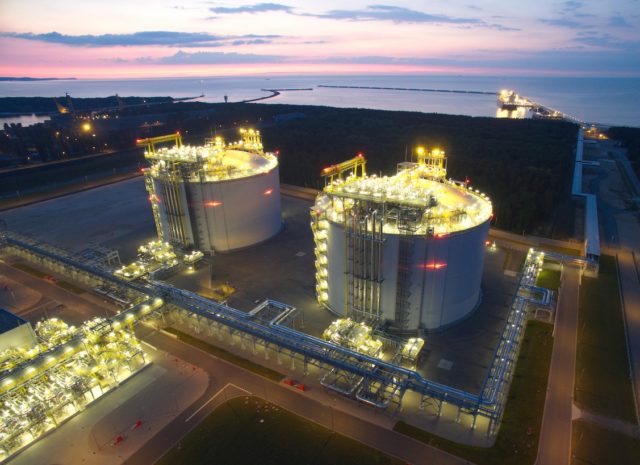
Ukraine to Decide Whether to Buy US LNG
Publication: Eurasia Daily Monitor Volume: 17 Issue: 98
By:

On May 27, the Ukrainian government preliminarily approved the text of a memorandum on the prospects for importing liquefied natural gas (LNG) from the United States. The document must still be signed by the Ukrainian side and the US company involved, the Lafayette-based Louisiana Natural Gas Exports (LNGE). The agreement reportedly envisages supplies of 5.5 billion cubic meters (bcm) of natural gas annually, for the period of 20 years (112.ua, June 15). Such volumes, however, will require additional gas infrastructure expansion in the region and, thus, may not happen earlier than in a few years. Another stumbling block is the fact that Ukraine’s Naftohaz appears to object to the US-proposed pricing formula (Interfax, June 10).
The idea of Ukraine purchasing LNG supplies from the United States is not new: the very first US cargo of the liquefied energy source was delivered to the Kyiv-based importer ERU Trading, via Poland, as early as June 2017 (Eru.com.ua, June 26, 2017). Moreover, Poland, Ukraine and the US signed a separate trilateral memorandum on cooperation on LNG sales back in 2019 (Premier.gov.pl, August 31, 2019). However, the whole process appears to have gained additional momentum in the past several months, as talks moved on from general discussions to the more detailed negotiations over the framework of the future cooperation.
The initial signal came in March of this year, when Ukraine’s deputy minister of energy and environmental protection, Konstantyn Chyzhyk, announced that Ukraine had already signed a Letter of Intent with Louisiana Natural Gas Exports (Interfax, March 13). The news was since confirmed two more times: first, on May 27, when the above-mentioned text of the memorandum on US LNG imports to Ukraine was preliminary approved by the government, and then again, in mid-June, when LNGE’s CEO, Ben Blanchett, gave two interviews to the Ukrainian media.
According to Blanchett, talks between the US and Ukrainian sides are still ongoing; however, the core of a possible long-term agreement has already been decided. Namely, US LNG deliveries for Ukraine are to be set for a 20-years period and will begin, at the earliest, in 2023. Annual supplies, amounting to as much as 5.5 bcm, will be delivered via Poland (Liga.net, June 15).
The key element of the proposed deal is to secure gas infrastructure expansion in Poland and Ukraine, which remains a necessary condition to actually enable regular, large-scale supplies of the US-produced natural gas to Ukrainian customers. For now, there is no free regasification capacity in Poland (despite the ongoing expansion of the Świnoujście LNG terminal), as all of the existing and to-be-brought-online capacities are already booked by Poland’s energy giant PGNiG (Polskielng.pl, May 29). Moreover, the preexisting gas interconnector between Poland and Ukraine is not sufficient either; its capacity is only 2 bcm per year, and flows can currently only move in one direction, to Ukraine.
What LNGE offers is to fully finance the construction of a new gas interconnector between the two Central and Eastern European countries. For this purpose, the US company is willing to invest around $300 million. Furthermore, the Louisiana gas producer is considering financing the “expansion of Polish regasification capacities” (Liga.net, June 15). LNGE has, to date, not elaborated on that latter point, however. Therefore, it remains unknown whether the company would like to see the further expansion of the Świnoujście LNG terminal (not confirmed if feasible) or to participate in the proposed 4 bcm floating storage regasification unit (FSRU) terminal project in Gdańsk (to be brought online by Poland’s GAZ-SYSTEM by the end of 2025) (Offshore-energy.biz, May 6, 2019).
Leaving aside the technical constraints mentioned above, the second main difficulty will be agreeing to a price formula between the Americans and Ukrainians. LNGE’s Blanchett has already described his firm’s proposed model, indicating that the US LNG price would be indexed to the Henry Hub natural gas price, which should make it competitive against spot supplies from the European TTF hub (112.ua, Liga.net, June 15, 2020). This, scheme and its underlying assumptions as to competitiveness, however, are being questioned by some of LNGE’s Ukrainian counterparts.
Naftohaz’s newly appointed COO, Otto Waterlander, has notably pointed to the inherent economic risk of a 20-year contract with no direct link to natural gas prices in Europe (Interfax, June 10). Whereas Naftohaz’s CEO, Andriy Kobolyev, has openly positioned himself as “skeptical” over the LNGE-proposed deal (Censor.net.ua, June 18). It remains to be seen whether lobbying efforts by Naftohaz will ultimately influence government officials in Kyiv to sour on the deal with the US LNG supplier.



